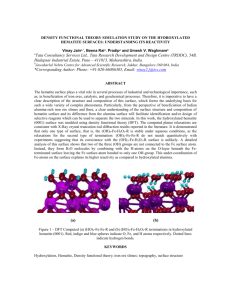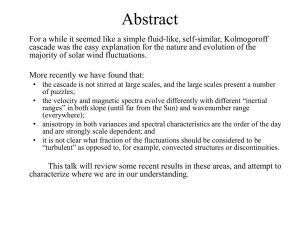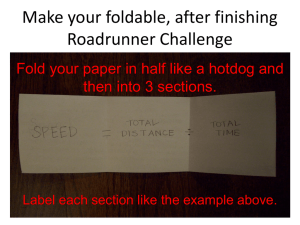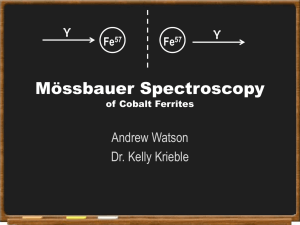Mössbauer Spectroscopy of Geological Materials
advertisement
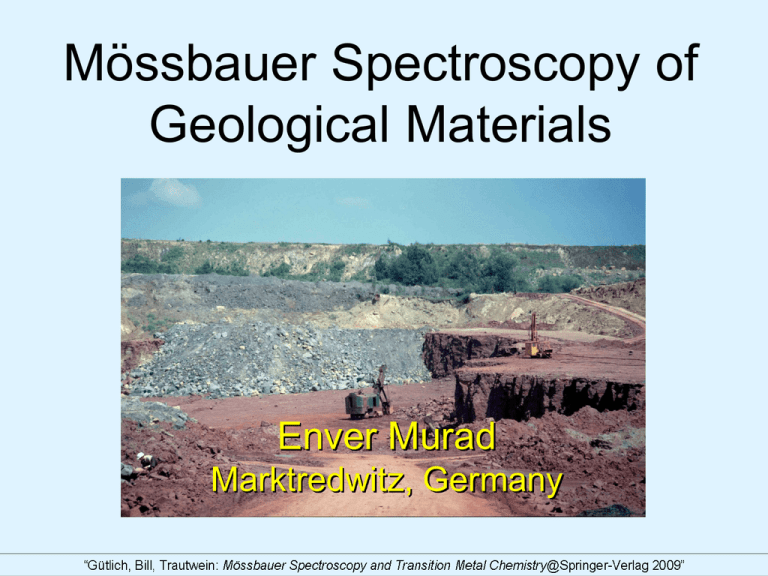
Mössbauer Spectroscopy of Geological Materials Enver Murad Marktredwitz, Germany 197Au 2% 121Sb 2% 119Sn 18 % Others 5% 57Fe 64 % Mössbauer publications: environmentally relevant isotopes (total in June 2006: > 46 000) MEDC 06/2006 100 Fe2+ Melanterite FeSO4 7H2O 98 96 Transmittance (%) 94 92 90 100 Fe3+ Schwertmannite Fe8O8(OH)6SO4 98 96 94 92 -5 -2.5 0 Velocity (mm/s) 2.5 5 Hematite @ 4.2 K Transmission Mössbauer spectrum of antiferromagnetic hematite (red) with a quadrupole interaction of +0.41 mm/s, and simulated hematite spectrum (black, dotted) fitted with the same hyperfine field but zero quadrupole interaction [ 0.00mm/s ] 0.41 mm/s -10 -5 0 Velocity (mm/s) 5 10 Kaolin / Jari @ 295 K 100 Transmission (%) 99.5 99 98.5 98 -7.5 -5 -2.5 0 2.5 5 7.5 Velocity (mm/s) The inner doublet (green doublet) refers to pure kaolinite. The measured spectrum shows considerable broadening due to paramagnetic relaxation. Kaolin / Jari @ 4.2 K Transmission (%) 100 99 98 97 -10 -5 0 5 10 Velocity (mm/s) The Mössbauer spectrum at 4.2 K shows, in addition to the doublet of pure kaolinite, a sextet arising from a paramagnetically relaxing component. This sextet is not to be confused with that of magnetically ordered hematite Kaolin CMS KGa-1 @ 295 K Transmission (%) 100 99.9 99.8 Fe3+ Fe2+ 99.7 -5 0 Velocity (mm/s) 5 Kaolin “Wolfka” @ 4.2 K 100.0 Transmission (%) 99.8 99.6 . 99.4 100.0 -I I 99.8 99.6 Goethite removed by Na dithionite extraction -10 -5 −0.11 % goethite 0 Velocity (mm/s) 5 10 Kaolin / Jari Mössbauer spectra (at 295 K) as function of firing temperature 2.0 Kaolin / Jari @ 295 K , (mm/s) 1.5 1.0 0.5 0.0 0 200 400 600 800 Firing temperature (°C) 1000 1200 Fe3+ oxides, oxyhydroxides and hydroxide that occur in nature Unit-Cell Dimensions (Å) c b a Structure Space Group corundum R3c 5.034 Fe3O4 inverse spinel Fd3m 8.396 γ-Fe2O3 disordered spinel Fd3m / or P422 Composition Mineral Occurrence Hematite very common α-Fe2O3 Magnetite common Maghemite common Goethite very common α-FeOOH Diaspore Pnma Akaganéite very rare β-FeOOH hollandite I2/m Lepidocrocite common γ-FeOOH boehmite Feroxyhite very rare δ’-FeOOH disordered CdI2 Ferrihydrite common Fe5HO8∙4H2O disordered corundum Bernalite extremely rare Fe(OH)3 disordered ReO3 13.752 8.3474 8.347 25.01 9.956 3.0215 4.608 10.600 3.034 10.513 Bbmm 3.071 12.52 3.873 P3m1 2.93 4.56 2.955 9.37 Immm 7.544 7.560 7.558 Mössbauer characteristics of naturally-occurring Fe3+ oxides sensu lato Mineral TN, TC MAG Bhf (K) δ/Fe Δ Δ Bhf Room Temperature 4.2 K Hematite 955 wfm 51.8 0.37 -0.20 53.5 or 54.2 -0.20 0.41 Magnetite 850 fim 49.2 46.1 0.26 0.67 50.6 36 – 52 0.00 1.18-(-0.79) ~ 950 fim 50.0 50.0 0.23 0.35 ≤ | 0.02 | ≤ | 0.02 | ≤ | 0.02 | ≤ | 0.02 | Goethite 400 afm 38.0 0.37 Akaganéite 299 afm – 77 afm Feroxyhite 450 Ferrihydrite Bernalite Maghemite Lepidocrocite 52.0 53.0 ≤ | 0.02 | ≤ | 0.02 | -0.26 50.6 -0.25 0.38 0.37 0.55 0.95 47.3 47.8 48.9 -0.81 -0.24 -0.02 – 0.37 0.53 45.8 0.02 fim 41 0.37 -0.06 53 52 115 25 spm – – 0.35 0.35 0.62 0.78 50 47 427 wfm 41.5 0.38 ≤ | 0.01 | 56.2 ~ 0.0 ~ 0.0 -0.07 -0.02 ≤ | 0.01 | Hematite and goethite: Al-for-Fe substitution Al3+ Fe3+ (r = 53.5 pm) (r = 64.5 pm) Hematite (Fe1-xAlx)2O3 0 ≤ x ≤ ~ 0.15 Goethite Fe1-xAlxOOH 0 ≤ x ≤ 0.33 100 Transmission (%) 95 90 85 80 -10 -5 0 Velocity (mm/s) 5 10 The effect of Al substitution is obvious in the spectrum of a hematite with 0.43 % substitution at 4.2 K, which displays coexisting components that have (blue subspectrum) and have not (red subspectrum) passed through a Morin transition. 60 Bhf (T) 40 Goethite 20 -10 -5 0 5 10 Hematite -10 0 0 200 -5 0 400 5 10 600 T (K) The graph shows the temperaturedependence of the magnetic hyperfine fields of hematite (red) and goethite (black). The vertical lines correspond to 295 and 77 K and the insets show room-temperature Mössbauer spectra of a pure goethite and a pure hematite 800 1000 Transmission (%) 100 100 98 97 96 94 94 91 92 P (Bhf) (%) -10 -5 a 0 5 10 -10 Velocity (mm/s) -5 b 0 5 10 Velocity (mm/s) 40 40 20 20 0 0 20 25 30 35 40 20 25 30 35 40 Transmission (%) 100 100 99 99 98 98 97 96 97 95 P (Bhf) (%) -10 -5 c 0 5 10 -10 Velocity (mm/s) -5 d 0 5 10 Velocity (mm/s) 40 40 20 20 0 0 20 25 30 Bhf (T) 35 40 20 25 30 Bhf (T) 35 Mössbauer spectra of goethite are characterized by asymmetric distributions of magnetic hyperfine fields. 40 The graph shows room-temperature spectra and the corresponding hyperfine field distributions of goethites of mean particle sizes in the [111] direction of 97 nm (a), 55 nm (b), 19 nm (c), and 25 nm (d). Sample a is a natural fibrous goethite and d was synthesized in the presence of Si. Ferrihydrite, Fe5HO8·4H2O, displays the following phenomena: paramagnetism, superparamagnetism, blocking temperatures, speromagnetism, hyperfine field distributions, recoil. The following two slides show Mössbauer spectra and hyperfine distributions of the two limiting ferrihydrite types, one exhibiting only two X-ray diffraction peaks (“2-p” sample; particle size ~ 2 nm) and the other exhibiting six X-ray diffraction peaks (“6-p”; particle size ~ 7 nm) recorded at room temperature and 4.2 K, respectively. Ferrihydrite @ 295 K 30 100 6-p 99 20 10 97 0 30 100 20 99 2-p 10 98 0 -2 -1 0 Velocity (mm/s) 1 20 1 2 (mm/s) 3 P () (%) Transmission (%) 98 Ferrihydrite @ 4.2 K 20 100 6-p Transmission (%) 96 12 94 8 92 4 90 0 20 100 16 99 2-p 98 12 8 97 96 4 95 0 -10 -5 0 Velocity (mm/s) 5 10 36 40 44 48 Bhf (T) 52 56 P (Bhf) (%) 16 98 A commercial iron oxide catalyst (“Nanocat ®”), which consists of isolated “FeOOH” (more probably ferrihydrite) particles ~ 3 nm in size shows decreasing absorption of gamma radiation and no Mössbauer spectra at all above 50 K because of particle recoil. 100 Transmission (%) 99.5 45 K 100 99 98 97 10 K -12 -8 -4 0 Velocity (mm/s) 4 8 Adapted from 12 Ganguly et al.,1994 Magnetite and Maghemite, Fe3O4 and -Fe2O3 display the following phenomena: ferrimagnetism, Verwey temperature, non-stoichiometry. 100 Magnetite, Fe3O4 Fetet3+[Fe2+Fe3+]octO4 99 The spectrum measured at room temperature can be separated into two sextets. One sextet arises from Fe3+ ions in tetrahedral sites, the other from iron in octahedral sites with fast electronic fluctuation between Fe2+ and Fe3+ in octahedral sites. 98 Transmission (%) 97 295 K 96 . 95 100 Below the Verwey transitions (ca. 120 K), Mössbauer spectra of magnetite are very complex due to a variety of lattice sites with different surroundings. The spectrum taken at 4.2 K has been deconvoluted into five sextets. 99 98 97 4.2 K 96 -10 -5 0 Velocity (mm/s) 5 10 100 Magnetite @ 160 K Transmission (%) 97 Bext = 0 94 91 100 98 96 Bext = 6 T // 94 92 -14 -7 0 Velocity (mm/s) 7 14 Magnetite @ 295 K 100 Mössbauer spectra (at 295 K) as a function of aging time. 98 + 6 months Fe3+ [Fe3+1.28Fe2+0.570.14] O4 Transmission (%) 96 94 100 + 99 months Fe3+ [Fe3+1.39Fe2+0.410.20]O4 98 96 94 -10 -5 0 Velocity (mm/s) 5 10 With increasing ageing time, Fe2+ is increasingly oxidized to Fe3+, as shown by the relative increase of the intensity of the Fe3+ sextet (larger field) compared to that of Fe“2.5 +” (red arrows). Maghemite @ 295 K Transmission (%) 100 The room temperature spectrum can be separated into two magnetic sextets, one (dotted line) arising from Fe3+ in tetrahedral and one (dashed line) from Fe3+ ions in octahedral sites. 99 98 97 96 Fe2O3 = Fe[Fe5/3□1/3]O4 -10 -5 0 Velocity (mm/s) 5 10 “Green rusts”, Fe2+-Fe3+-double layered hydroxides (“DLHs”), display the following phenomena: temporal instability, rapid oxidation, therefore problematic identification in nature, characteristic Mössbauer parameters. “Green rust” (Fex2+Fe23+(OH)2x+4 CO3 (x-2)H2O) @ 120 K Relative Transmission (%) 100 96 92 88 84 -4 -3 -2 -1 0 Velocity (mm/s) 1 2 3 4 Natural green rust (“fougerite”) J.-M.R. Génin 100 96 Oxidation of the Fe2+Fe3+ hydroxycarbonate green rust shown in the previous slide as a function of reaction at room temperature (all spectra recorded at 120 K). t=0 92 88 84 Transmission (%) 100 96 t = 20 min 92 88 84 100 t = 40 min 96 92 88 -4 -2 0 Velocity ( mm/s) 2 4 Complex natural systems Room-temperature Mössbauer spectra of a “standard” bauxite before (top) and after (bottom) 3 treatments with dithionite-citratebicarbonate (DCB) to remove iron oxides (in the present case hematite). 100 Transmittance (%) 98 Bauxite BX-N 96 100 99 After 3 DCB treatments 295 K 98 -10 -5 0 Velocity (mm/s) 5 10 These treatments reduced the Fe2O3 contents of the sample from 22.88 % to 1.50 mass %. The bottom spectrum shows the remnant hematite to be identical to that which was extracted. 100 98 Mössbauer spectra of the clay fraction (< 2 µm) of a red soil from the northern Alpine foreland taken at the indicated temperatures. 295 K 96 94 Transmission (%) 92 120 K 100 98 96 100 77 K 98 96 100 4.2 K 98 96 -10 -5 0 Velocity (mm/s) 5 10 The spectra show the iron oxides (hematite, αFe2O3, outer sextet and goethite, αFeOOH, inner sextet) contained in the soil to order magnetically over a broad range of temperatures as a result of superparamagnetic relaxation.

